University Research Proposal: Beneficial Antioxidant Effect of I3C
VerifiedAdded on 2023/01/20
|27
|9155
|72
Project
AI Summary
This research proposal investigates the beneficial antioxidant effects of Indole-3-Carbinol (I3C), a compound found in cruciferous vegetables. The study aims to evaluate I3C's potential in reducing oxidative stress, preventing cancer, and improving overall health. The rationale emphasizes the importance of antioxidants in combating cellular and tissue damage, highlighting the role of I3C in detoxification, apoptosis induction, and cell cycle regulation. The proposal outlines the need for a clinical trial to determine the optimal dosage and therapeutic applications of I3C, considering its impact on metabolic disorders and the limitations of existing research. The background of the study emphasizes the plant's role in promoting health, and the potential of I3C in preventing age-related diseases and influencing nutritional intake. The research seeks to address the growing concern over diet and lifestyle, and the increasing prevalence of metabolism-related disorders. It aims to analyze the cellular physiology and pathophysiology of I3C's antioxidant effect through data collection and descriptive research over a six-month period. The study will review the existing literature and investigate the anti-oxidant property of Indole 3 carbinol with the help of random control study, where the administration of the dose of indole 3 carbinol and its effect on the tumour growth has to be studied and evaluated.
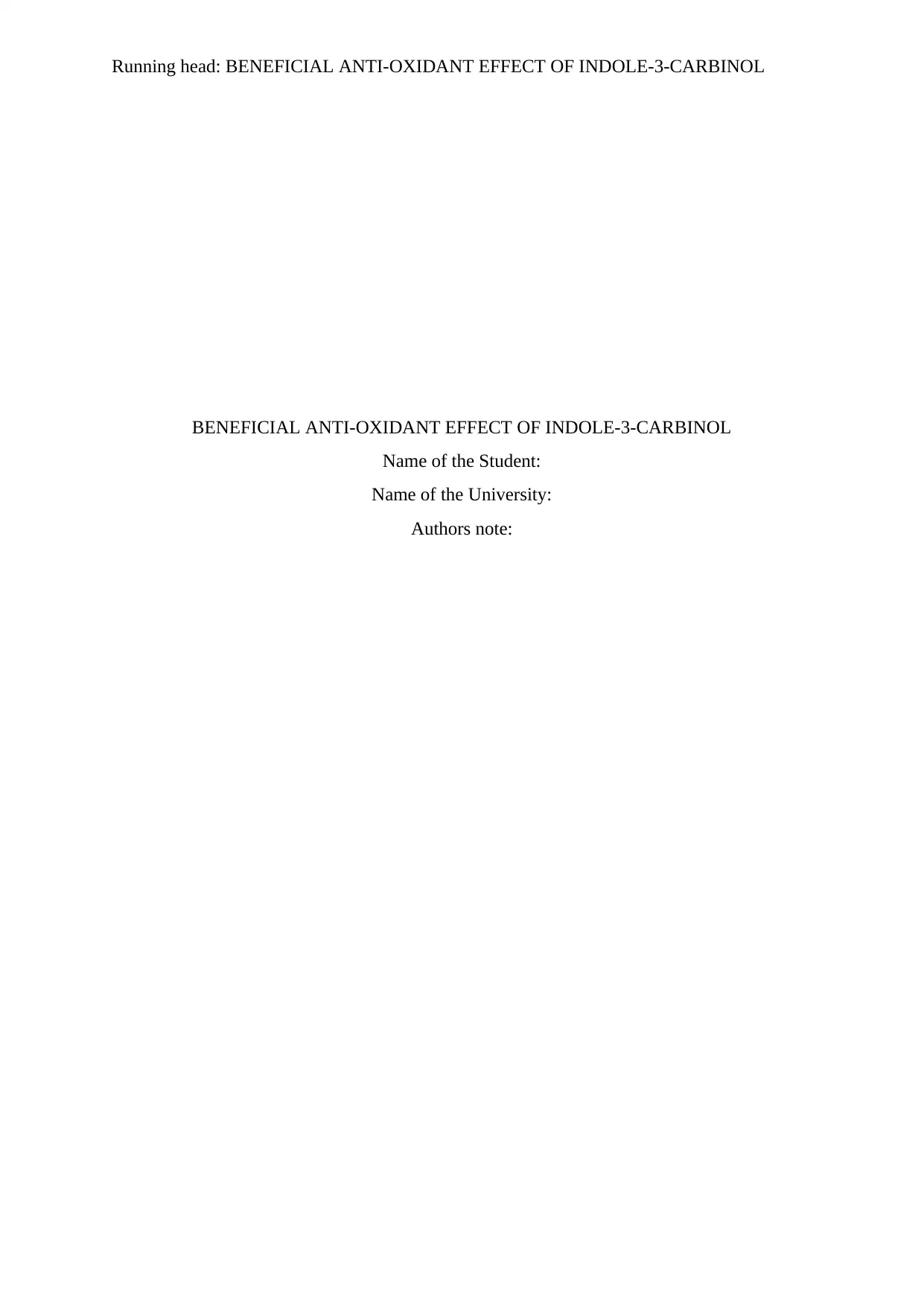
Running head: BENEFICIAL ANTI-OXIDANT EFFECT OF INDOLE-3-CARBINOL
BENEFICIAL ANTI-OXIDANT EFFECT OF INDOLE-3-CARBINOL
Name of the Student:
Name of the University:
Authors note:
BENEFICIAL ANTI-OXIDANT EFFECT OF INDOLE-3-CARBINOL
Name of the Student:
Name of the University:
Authors note:
Paraphrase This Document
Need a fresh take? Get an instant paraphrase of this document with our AI Paraphraser
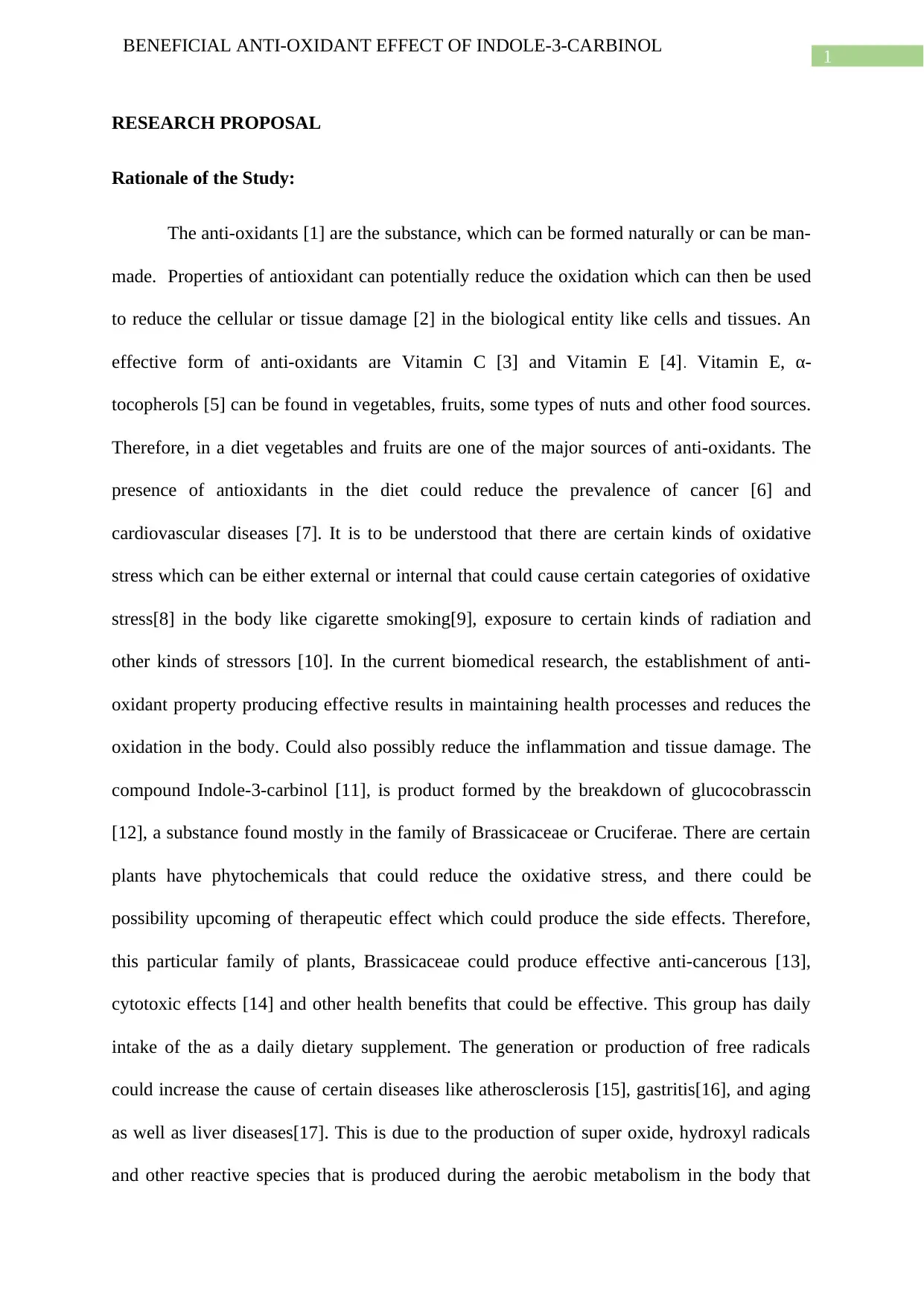
1
BENEFICIAL ANTI-OXIDANT EFFECT OF INDOLE-3-CARBINOL
RESEARCH PROPOSAL
Rationale of the Study:
The anti-oxidants [1] are the substance, which can be formed naturally or can be man-
made. Properties of antioxidant can potentially reduce the oxidation which can then be used
to reduce the cellular or tissue damage [2] in the biological entity like cells and tissues. An
effective form of anti-oxidants are Vitamin C [3] and Vitamin E [4]. Vitamin E, α-
tocopherols [5] can be found in vegetables, fruits, some types of nuts and other food sources.
Therefore, in a diet vegetables and fruits are one of the major sources of anti-oxidants. The
presence of antioxidants in the diet could reduce the prevalence of cancer [6] and
cardiovascular diseases [7]. It is to be understood that there are certain kinds of oxidative
stress which can be either external or internal that could cause certain categories of oxidative
stress[8] in the body like cigarette smoking[9], exposure to certain kinds of radiation and
other kinds of stressors [10]. In the current biomedical research, the establishment of anti-
oxidant property producing effective results in maintaining health processes and reduces the
oxidation in the body. Could also possibly reduce the inflammation and tissue damage. The
compound Indole-3-carbinol [11], is product formed by the breakdown of glucocobrasscin
[12], a substance found mostly in the family of Brassicaceae or Cruciferae. There are certain
plants have phytochemicals that could reduce the oxidative stress, and there could be
possibility upcoming of therapeutic effect which could produce the side effects. Therefore,
this particular family of plants, Brassicaceae could produce effective anti-cancerous [13],
cytotoxic effects [14] and other health benefits that could be effective. This group has daily
intake of the as a daily dietary supplement. The generation or production of free radicals
could increase the cause of certain diseases like atherosclerosis [15], gastritis[16], and aging
as well as liver diseases[17]. This is due to the production of super oxide, hydroxyl radicals
and other reactive species that is produced during the aerobic metabolism in the body that
BENEFICIAL ANTI-OXIDANT EFFECT OF INDOLE-3-CARBINOL
RESEARCH PROPOSAL
Rationale of the Study:
The anti-oxidants [1] are the substance, which can be formed naturally or can be man-
made. Properties of antioxidant can potentially reduce the oxidation which can then be used
to reduce the cellular or tissue damage [2] in the biological entity like cells and tissues. An
effective form of anti-oxidants are Vitamin C [3] and Vitamin E [4]. Vitamin E, α-
tocopherols [5] can be found in vegetables, fruits, some types of nuts and other food sources.
Therefore, in a diet vegetables and fruits are one of the major sources of anti-oxidants. The
presence of antioxidants in the diet could reduce the prevalence of cancer [6] and
cardiovascular diseases [7]. It is to be understood that there are certain kinds of oxidative
stress which can be either external or internal that could cause certain categories of oxidative
stress[8] in the body like cigarette smoking[9], exposure to certain kinds of radiation and
other kinds of stressors [10]. In the current biomedical research, the establishment of anti-
oxidant property producing effective results in maintaining health processes and reduces the
oxidation in the body. Could also possibly reduce the inflammation and tissue damage. The
compound Indole-3-carbinol [11], is product formed by the breakdown of glucocobrasscin
[12], a substance found mostly in the family of Brassicaceae or Cruciferae. There are certain
plants have phytochemicals that could reduce the oxidative stress, and there could be
possibility upcoming of therapeutic effect which could produce the side effects. Therefore,
this particular family of plants, Brassicaceae could produce effective anti-cancerous [13],
cytotoxic effects [14] and other health benefits that could be effective. This group has daily
intake of the as a daily dietary supplement. The generation or production of free radicals
could increase the cause of certain diseases like atherosclerosis [15], gastritis[16], and aging
as well as liver diseases[17]. This is due to the production of super oxide, hydroxyl radicals
and other reactive species that is produced during the aerobic metabolism in the body that
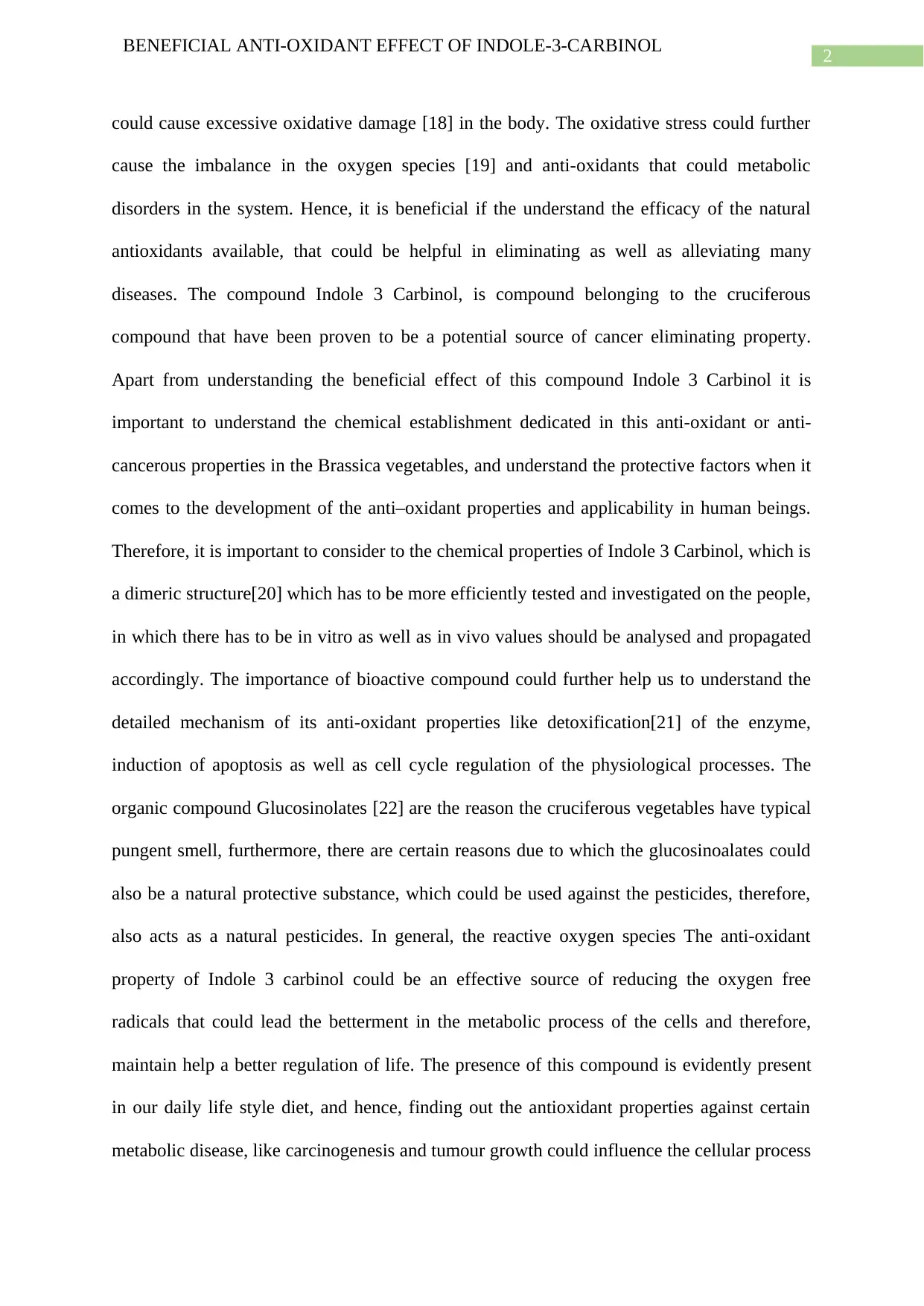
2
BENEFICIAL ANTI-OXIDANT EFFECT OF INDOLE-3-CARBINOL
could cause excessive oxidative damage [18] in the body. The oxidative stress could further
cause the imbalance in the oxygen species [19] and anti-oxidants that could metabolic
disorders in the system. Hence, it is beneficial if the understand the efficacy of the natural
antioxidants available, that could be helpful in eliminating as well as alleviating many
diseases. The compound Indole 3 Carbinol, is compound belonging to the cruciferous
compound that have been proven to be a potential source of cancer eliminating property.
Apart from understanding the beneficial effect of this compound Indole 3 Carbinol it is
important to understand the chemical establishment dedicated in this anti-oxidant or anti-
cancerous properties in the Brassica vegetables, and understand the protective factors when it
comes to the development of the anti–oxidant properties and applicability in human beings.
Therefore, it is important to consider to the chemical properties of Indole 3 Carbinol, which is
a dimeric structure[20] which has to be more efficiently tested and investigated on the people,
in which there has to be in vitro as well as in vivo values should be analysed and propagated
accordingly. The importance of bioactive compound could further help us to understand the
detailed mechanism of its anti-oxidant properties like detoxification[21] of the enzyme,
induction of apoptosis as well as cell cycle regulation of the physiological processes. The
organic compound Glucosinolates [22] are the reason the cruciferous vegetables have typical
pungent smell, furthermore, there are certain reasons due to which the glucosinoalates could
also be a natural protective substance, which could be used against the pesticides, therefore,
also acts as a natural pesticides. In general, the reactive oxygen species The anti-oxidant
property of Indole 3 carbinol could be an effective source of reducing the oxygen free
radicals that could lead the betterment in the metabolic process of the cells and therefore,
maintain help a better regulation of life. The presence of this compound is evidently present
in our daily life style diet, and hence, finding out the antioxidant properties against certain
metabolic disease, like carcinogenesis and tumour growth could influence the cellular process
BENEFICIAL ANTI-OXIDANT EFFECT OF INDOLE-3-CARBINOL
could cause excessive oxidative damage [18] in the body. The oxidative stress could further
cause the imbalance in the oxygen species [19] and anti-oxidants that could metabolic
disorders in the system. Hence, it is beneficial if the understand the efficacy of the natural
antioxidants available, that could be helpful in eliminating as well as alleviating many
diseases. The compound Indole 3 Carbinol, is compound belonging to the cruciferous
compound that have been proven to be a potential source of cancer eliminating property.
Apart from understanding the beneficial effect of this compound Indole 3 Carbinol it is
important to understand the chemical establishment dedicated in this anti-oxidant or anti-
cancerous properties in the Brassica vegetables, and understand the protective factors when it
comes to the development of the anti–oxidant properties and applicability in human beings.
Therefore, it is important to consider to the chemical properties of Indole 3 Carbinol, which is
a dimeric structure[20] which has to be more efficiently tested and investigated on the people,
in which there has to be in vitro as well as in vivo values should be analysed and propagated
accordingly. The importance of bioactive compound could further help us to understand the
detailed mechanism of its anti-oxidant properties like detoxification[21] of the enzyme,
induction of apoptosis as well as cell cycle regulation of the physiological processes. The
organic compound Glucosinolates [22] are the reason the cruciferous vegetables have typical
pungent smell, furthermore, there are certain reasons due to which the glucosinoalates could
also be a natural protective substance, which could be used against the pesticides, therefore,
also acts as a natural pesticides. In general, the reactive oxygen species The anti-oxidant
property of Indole 3 carbinol could be an effective source of reducing the oxygen free
radicals that could lead the betterment in the metabolic process of the cells and therefore,
maintain help a better regulation of life. The presence of this compound is evidently present
in our daily life style diet, and hence, finding out the antioxidant properties against certain
metabolic disease, like carcinogenesis and tumour growth could influence the cellular process
⊘ This is a preview!⊘
Do you want full access?
Subscribe today to unlock all pages.

Trusted by 1+ million students worldwide
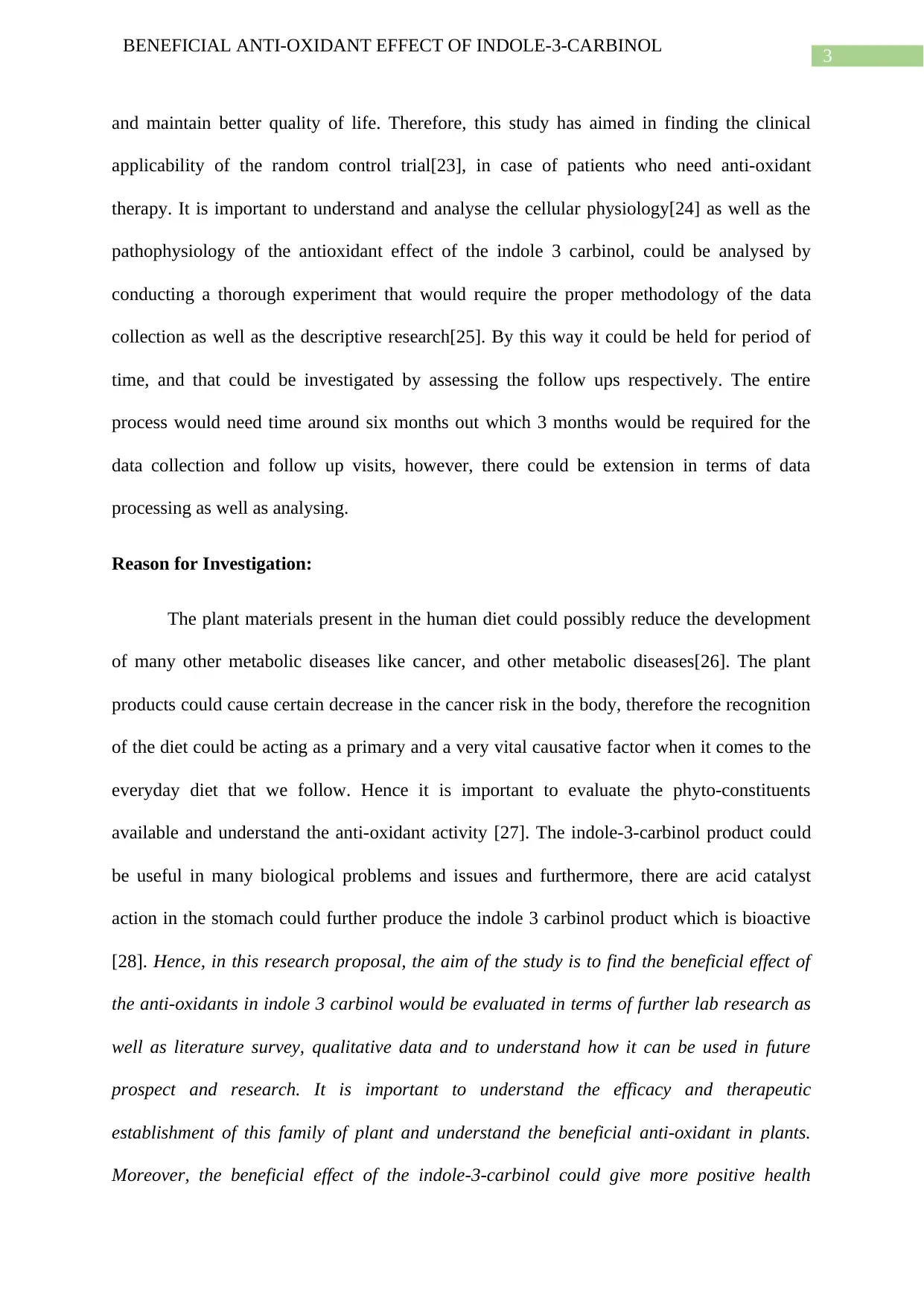
3
BENEFICIAL ANTI-OXIDANT EFFECT OF INDOLE-3-CARBINOL
and maintain better quality of life. Therefore, this study has aimed in finding the clinical
applicability of the random control trial[23], in case of patients who need anti-oxidant
therapy. It is important to understand and analyse the cellular physiology[24] as well as the
pathophysiology of the antioxidant effect of the indole 3 carbinol, could be analysed by
conducting a thorough experiment that would require the proper methodology of the data
collection as well as the descriptive research[25]. By this way it could be held for period of
time, and that could be investigated by assessing the follow ups respectively. The entire
process would need time around six months out which 3 months would be required for the
data collection and follow up visits, however, there could be extension in terms of data
processing as well as analysing.
Reason for Investigation:
The plant materials present in the human diet could possibly reduce the development
of many other metabolic diseases like cancer, and other metabolic diseases[26]. The plant
products could cause certain decrease in the cancer risk in the body, therefore the recognition
of the diet could be acting as a primary and a very vital causative factor when it comes to the
everyday diet that we follow. Hence it is important to evaluate the phyto-constituents
available and understand the anti-oxidant activity [27]. The indole-3-carbinol product could
be useful in many biological problems and issues and furthermore, there are acid catalyst
action in the stomach could further produce the indole 3 carbinol product which is bioactive
[28]. Hence, in this research proposal, the aim of the study is to find the beneficial effect of
the anti-oxidants in indole 3 carbinol would be evaluated in terms of further lab research as
well as literature survey, qualitative data and to understand how it can be used in future
prospect and research. It is important to understand the efficacy and therapeutic
establishment of this family of plant and understand the beneficial anti-oxidant in plants.
Moreover, the beneficial effect of the indole-3-carbinol could give more positive health
BENEFICIAL ANTI-OXIDANT EFFECT OF INDOLE-3-CARBINOL
and maintain better quality of life. Therefore, this study has aimed in finding the clinical
applicability of the random control trial[23], in case of patients who need anti-oxidant
therapy. It is important to understand and analyse the cellular physiology[24] as well as the
pathophysiology of the antioxidant effect of the indole 3 carbinol, could be analysed by
conducting a thorough experiment that would require the proper methodology of the data
collection as well as the descriptive research[25]. By this way it could be held for period of
time, and that could be investigated by assessing the follow ups respectively. The entire
process would need time around six months out which 3 months would be required for the
data collection and follow up visits, however, there could be extension in terms of data
processing as well as analysing.
Reason for Investigation:
The plant materials present in the human diet could possibly reduce the development
of many other metabolic diseases like cancer, and other metabolic diseases[26]. The plant
products could cause certain decrease in the cancer risk in the body, therefore the recognition
of the diet could be acting as a primary and a very vital causative factor when it comes to the
everyday diet that we follow. Hence it is important to evaluate the phyto-constituents
available and understand the anti-oxidant activity [27]. The indole-3-carbinol product could
be useful in many biological problems and issues and furthermore, there are acid catalyst
action in the stomach could further produce the indole 3 carbinol product which is bioactive
[28]. Hence, in this research proposal, the aim of the study is to find the beneficial effect of
the anti-oxidants in indole 3 carbinol would be evaluated in terms of further lab research as
well as literature survey, qualitative data and to understand how it can be used in future
prospect and research. It is important to understand the efficacy and therapeutic
establishment of this family of plant and understand the beneficial anti-oxidant in plants.
Moreover, the beneficial effect of the indole-3-carbinol could give more positive health
Paraphrase This Document
Need a fresh take? Get an instant paraphrase of this document with our AI Paraphraser
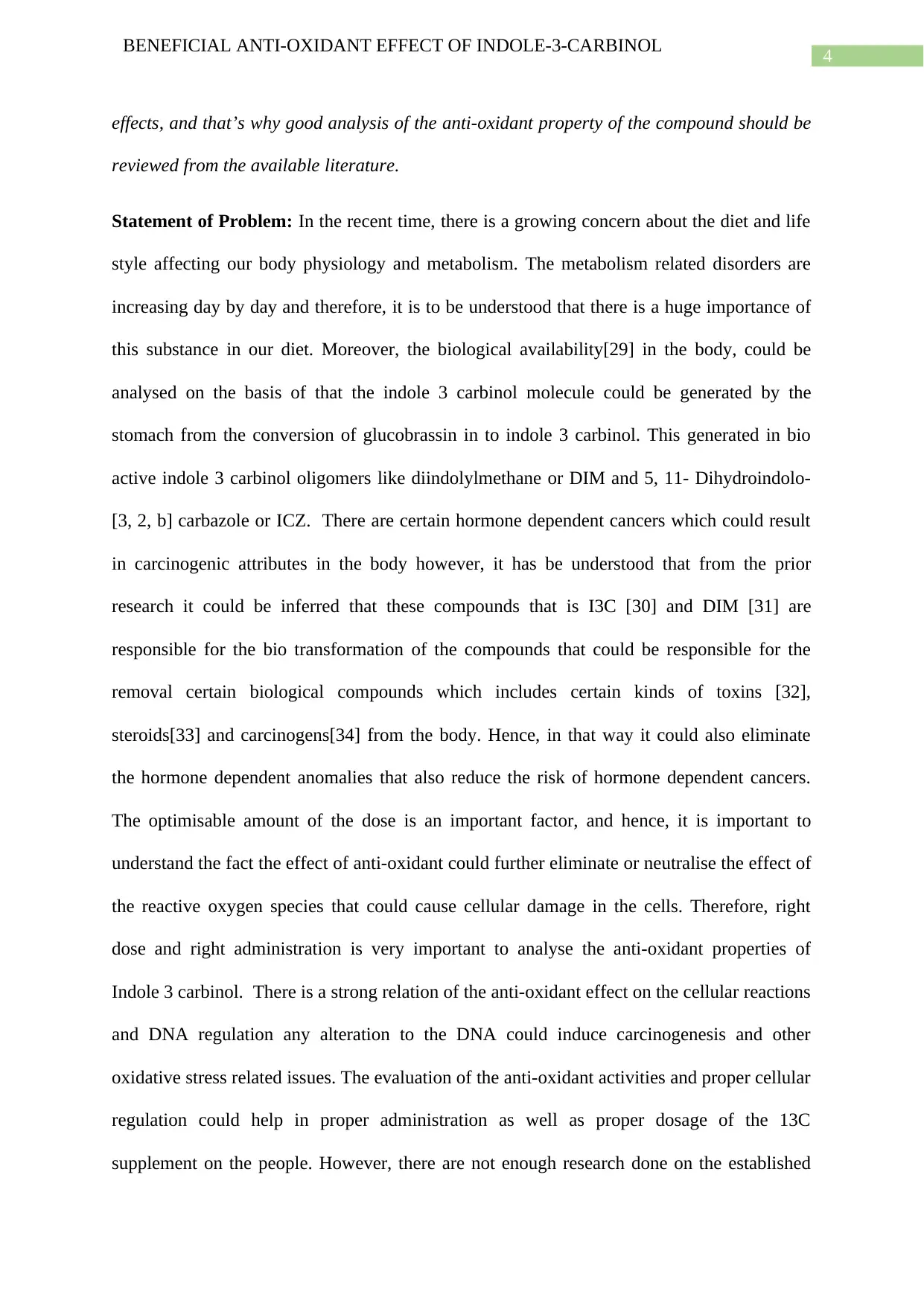
4
BENEFICIAL ANTI-OXIDANT EFFECT OF INDOLE-3-CARBINOL
effects, and that’s why good analysis of the anti-oxidant property of the compound should be
reviewed from the available literature.
Statement of Problem: In the recent time, there is a growing concern about the diet and life
style affecting our body physiology and metabolism. The metabolism related disorders are
increasing day by day and therefore, it is to be understood that there is a huge importance of
this substance in our diet. Moreover, the biological availability[29] in the body, could be
analysed on the basis of that the indole 3 carbinol molecule could be generated by the
stomach from the conversion of glucobrassin in to indole 3 carbinol. This generated in bio
active indole 3 carbinol oligomers like diindolylmethane or DIM and 5, 11- Dihydroindolo-
[3, 2, b] carbazole or ICZ. There are certain hormone dependent cancers which could result
in carcinogenic attributes in the body however, it has be understood that from the prior
research it could be inferred that these compounds that is I3C [30] and DIM [31] are
responsible for the bio transformation of the compounds that could be responsible for the
removal certain biological compounds which includes certain kinds of toxins [32],
steroids[33] and carcinogens[34] from the body. Hence, in that way it could also eliminate
the hormone dependent anomalies that also reduce the risk of hormone dependent cancers.
The optimisable amount of the dose is an important factor, and hence, it is important to
understand the fact the effect of anti-oxidant could further eliminate or neutralise the effect of
the reactive oxygen species that could cause cellular damage in the cells. Therefore, right
dose and right administration is very important to analyse the anti-oxidant properties of
Indole 3 carbinol. There is a strong relation of the anti-oxidant effect on the cellular reactions
and DNA regulation any alteration to the DNA could induce carcinogenesis and other
oxidative stress related issues. The evaluation of the anti-oxidant activities and proper cellular
regulation could help in proper administration as well as proper dosage of the 13C
supplement on the people. However, there are not enough research done on the established
BENEFICIAL ANTI-OXIDANT EFFECT OF INDOLE-3-CARBINOL
effects, and that’s why good analysis of the anti-oxidant property of the compound should be
reviewed from the available literature.
Statement of Problem: In the recent time, there is a growing concern about the diet and life
style affecting our body physiology and metabolism. The metabolism related disorders are
increasing day by day and therefore, it is to be understood that there is a huge importance of
this substance in our diet. Moreover, the biological availability[29] in the body, could be
analysed on the basis of that the indole 3 carbinol molecule could be generated by the
stomach from the conversion of glucobrassin in to indole 3 carbinol. This generated in bio
active indole 3 carbinol oligomers like diindolylmethane or DIM and 5, 11- Dihydroindolo-
[3, 2, b] carbazole or ICZ. There are certain hormone dependent cancers which could result
in carcinogenic attributes in the body however, it has be understood that from the prior
research it could be inferred that these compounds that is I3C [30] and DIM [31] are
responsible for the bio transformation of the compounds that could be responsible for the
removal certain biological compounds which includes certain kinds of toxins [32],
steroids[33] and carcinogens[34] from the body. Hence, in that way it could also eliminate
the hormone dependent anomalies that also reduce the risk of hormone dependent cancers.
The optimisable amount of the dose is an important factor, and hence, it is important to
understand the fact the effect of anti-oxidant could further eliminate or neutralise the effect of
the reactive oxygen species that could cause cellular damage in the cells. Therefore, right
dose and right administration is very important to analyse the anti-oxidant properties of
Indole 3 carbinol. There is a strong relation of the anti-oxidant effect on the cellular reactions
and DNA regulation any alteration to the DNA could induce carcinogenesis and other
oxidative stress related issues. The evaluation of the anti-oxidant activities and proper cellular
regulation could help in proper administration as well as proper dosage of the 13C
supplement on the people. However, there are not enough research done on the established
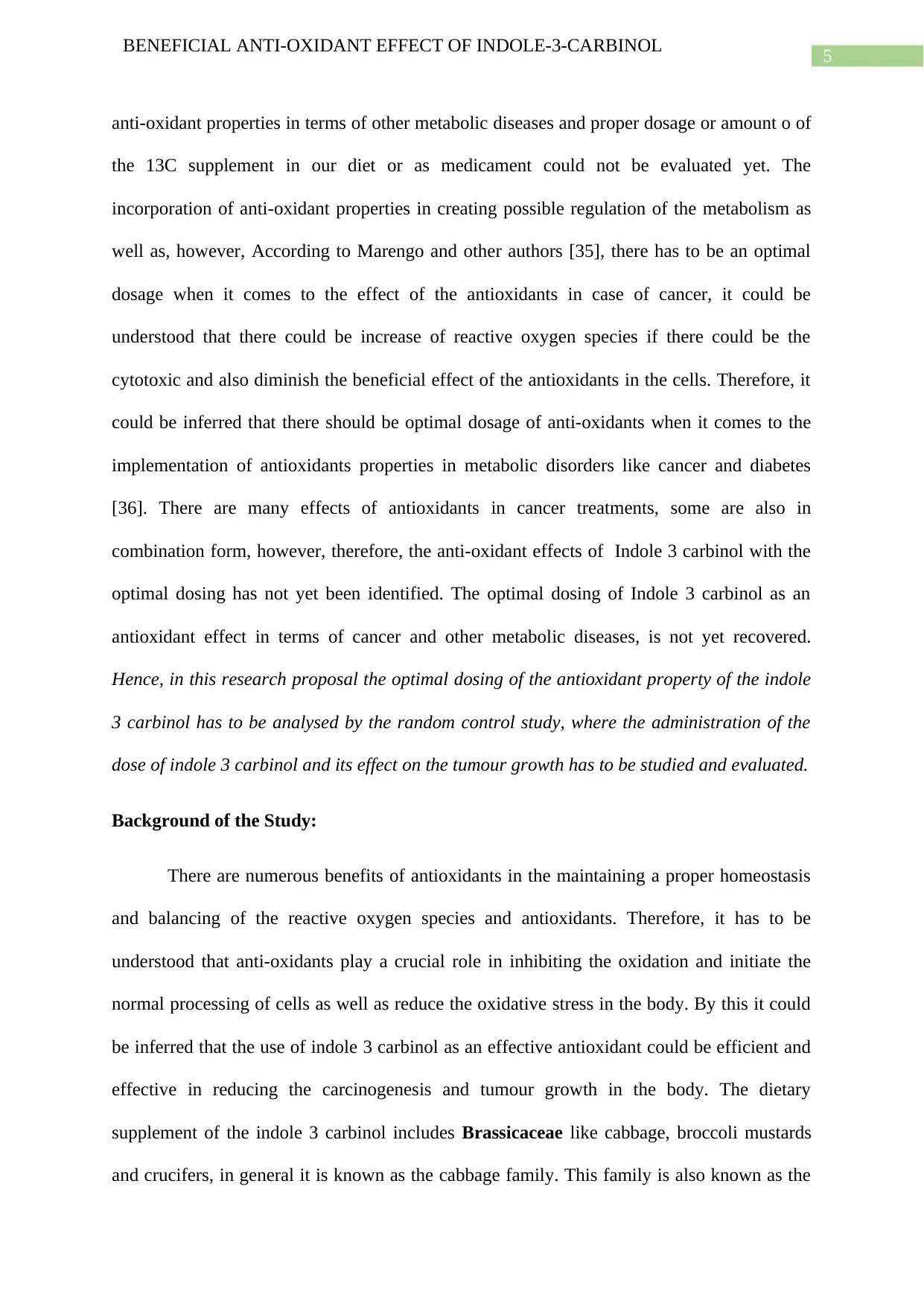
5
BENEFICIAL ANTI-OXIDANT EFFECT OF INDOLE-3-CARBINOL
anti-oxidant properties in terms of other metabolic diseases and proper dosage or amount o of
the 13C supplement in our diet or as medicament could not be evaluated yet. The
incorporation of anti-oxidant properties in creating possible regulation of the metabolism as
well as, however, According to Marengo and other authors [35], there has to be an optimal
dosage when it comes to the effect of the antioxidants in case of cancer, it could be
understood that there could be increase of reactive oxygen species if there could be the
cytotoxic and also diminish the beneficial effect of the antioxidants in the cells. Therefore, it
could be inferred that there should be optimal dosage of anti-oxidants when it comes to the
implementation of antioxidants properties in metabolic disorders like cancer and diabetes
[36]. There are many effects of antioxidants in cancer treatments, some are also in
combination form, however, therefore, the anti-oxidant effects of Indole 3 carbinol with the
optimal dosing has not yet been identified. The optimal dosing of Indole 3 carbinol as an
antioxidant effect in terms of cancer and other metabolic diseases, is not yet recovered.
Hence, in this research proposal the optimal dosing of the antioxidant property of the indole
3 carbinol has to be analysed by the random control study, where the administration of the
dose of indole 3 carbinol and its effect on the tumour growth has to be studied and evaluated.
Background of the Study:
There are numerous benefits of antioxidants in the maintaining a proper homeostasis
and balancing of the reactive oxygen species and antioxidants. Therefore, it has to be
understood that anti-oxidants play a crucial role in inhibiting the oxidation and initiate the
normal processing of cells as well as reduce the oxidative stress in the body. By this it could
be inferred that the use of indole 3 carbinol as an effective antioxidant could be efficient and
effective in reducing the carcinogenesis and tumour growth in the body. The dietary
supplement of the indole 3 carbinol includes Brassicaceae like cabbage, broccoli mustards
and crucifers, in general it is known as the cabbage family. This family is also known as the
BENEFICIAL ANTI-OXIDANT EFFECT OF INDOLE-3-CARBINOL
anti-oxidant properties in terms of other metabolic diseases and proper dosage or amount o of
the 13C supplement in our diet or as medicament could not be evaluated yet. The
incorporation of anti-oxidant properties in creating possible regulation of the metabolism as
well as, however, According to Marengo and other authors [35], there has to be an optimal
dosage when it comes to the effect of the antioxidants in case of cancer, it could be
understood that there could be increase of reactive oxygen species if there could be the
cytotoxic and also diminish the beneficial effect of the antioxidants in the cells. Therefore, it
could be inferred that there should be optimal dosage of anti-oxidants when it comes to the
implementation of antioxidants properties in metabolic disorders like cancer and diabetes
[36]. There are many effects of antioxidants in cancer treatments, some are also in
combination form, however, therefore, the anti-oxidant effects of Indole 3 carbinol with the
optimal dosing has not yet been identified. The optimal dosing of Indole 3 carbinol as an
antioxidant effect in terms of cancer and other metabolic diseases, is not yet recovered.
Hence, in this research proposal the optimal dosing of the antioxidant property of the indole
3 carbinol has to be analysed by the random control study, where the administration of the
dose of indole 3 carbinol and its effect on the tumour growth has to be studied and evaluated.
Background of the Study:
There are numerous benefits of antioxidants in the maintaining a proper homeostasis
and balancing of the reactive oxygen species and antioxidants. Therefore, it has to be
understood that anti-oxidants play a crucial role in inhibiting the oxidation and initiate the
normal processing of cells as well as reduce the oxidative stress in the body. By this it could
be inferred that the use of indole 3 carbinol as an effective antioxidant could be efficient and
effective in reducing the carcinogenesis and tumour growth in the body. The dietary
supplement of the indole 3 carbinol includes Brassicaceae like cabbage, broccoli mustards
and crucifers, in general it is known as the cabbage family. This family is also known as the
⊘ This is a preview!⊘
Do you want full access?
Subscribe today to unlock all pages.

Trusted by 1+ million students worldwide
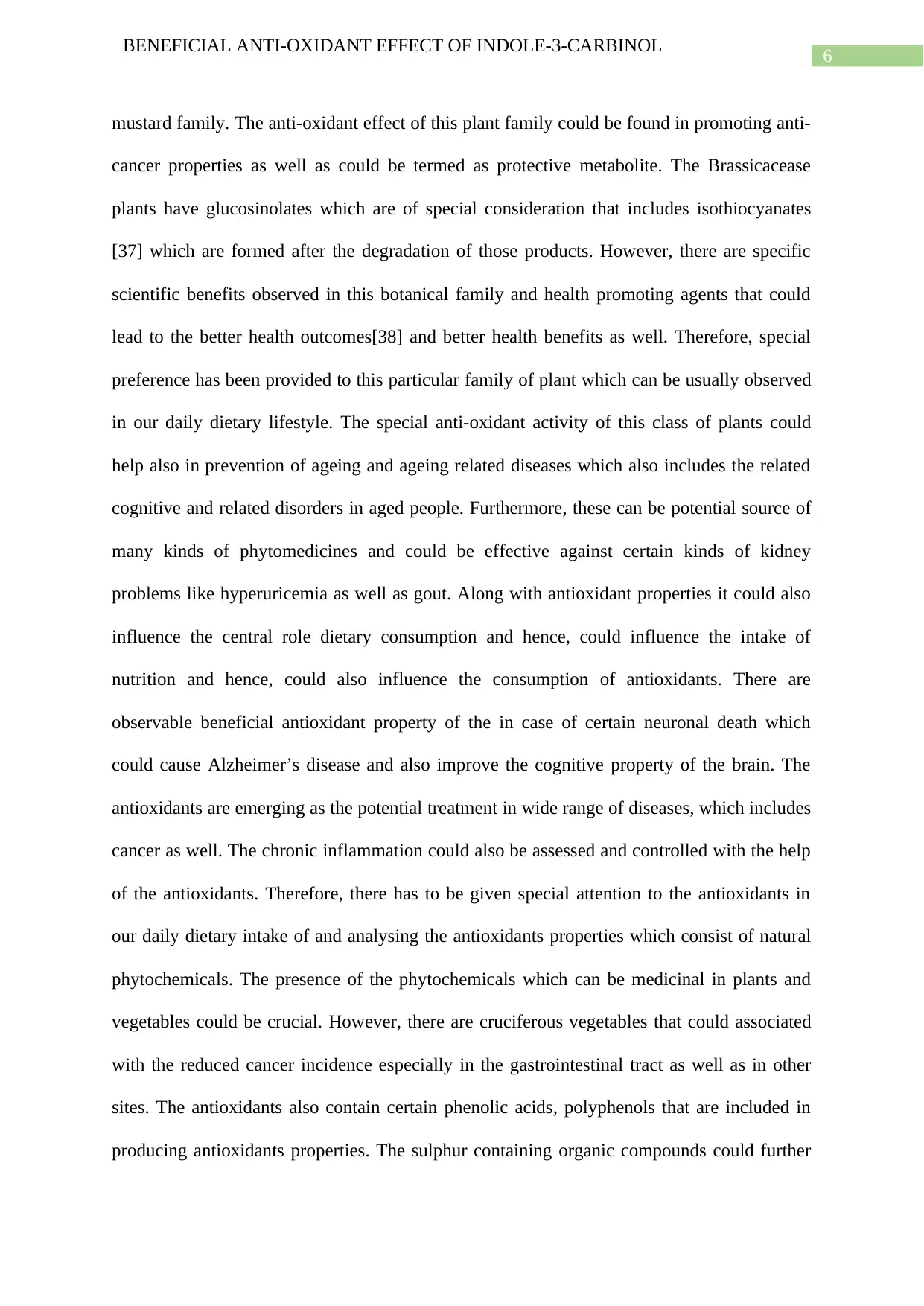
6
BENEFICIAL ANTI-OXIDANT EFFECT OF INDOLE-3-CARBINOL
mustard family. The anti-oxidant effect of this plant family could be found in promoting anti-
cancer properties as well as could be termed as protective metabolite. The Brassicacease
plants have glucosinolates which are of special consideration that includes isothiocyanates
[37] which are formed after the degradation of those products. However, there are specific
scientific benefits observed in this botanical family and health promoting agents that could
lead to the better health outcomes[38] and better health benefits as well. Therefore, special
preference has been provided to this particular family of plant which can be usually observed
in our daily dietary lifestyle. The special anti-oxidant activity of this class of plants could
help also in prevention of ageing and ageing related diseases which also includes the related
cognitive and related disorders in aged people. Furthermore, these can be potential source of
many kinds of phytomedicines and could be effective against certain kinds of kidney
problems like hyperuricemia as well as gout. Along with antioxidant properties it could also
influence the central role dietary consumption and hence, could influence the intake of
nutrition and hence, could also influence the consumption of antioxidants. There are
observable beneficial antioxidant property of the in case of certain neuronal death which
could cause Alzheimer’s disease and also improve the cognitive property of the brain. The
antioxidants are emerging as the potential treatment in wide range of diseases, which includes
cancer as well. The chronic inflammation could also be assessed and controlled with the help
of the antioxidants. Therefore, there has to be given special attention to the antioxidants in
our daily dietary intake of and analysing the antioxidants properties which consist of natural
phytochemicals. The presence of the phytochemicals which can be medicinal in plants and
vegetables could be crucial. However, there are cruciferous vegetables that could associated
with the reduced cancer incidence especially in the gastrointestinal tract as well as in other
sites. The antioxidants also contain certain phenolic acids, polyphenols that are included in
producing antioxidants properties. The sulphur containing organic compounds could further
BENEFICIAL ANTI-OXIDANT EFFECT OF INDOLE-3-CARBINOL
mustard family. The anti-oxidant effect of this plant family could be found in promoting anti-
cancer properties as well as could be termed as protective metabolite. The Brassicacease
plants have glucosinolates which are of special consideration that includes isothiocyanates
[37] which are formed after the degradation of those products. However, there are specific
scientific benefits observed in this botanical family and health promoting agents that could
lead to the better health outcomes[38] and better health benefits as well. Therefore, special
preference has been provided to this particular family of plant which can be usually observed
in our daily dietary lifestyle. The special anti-oxidant activity of this class of plants could
help also in prevention of ageing and ageing related diseases which also includes the related
cognitive and related disorders in aged people. Furthermore, these can be potential source of
many kinds of phytomedicines and could be effective against certain kinds of kidney
problems like hyperuricemia as well as gout. Along with antioxidant properties it could also
influence the central role dietary consumption and hence, could influence the intake of
nutrition and hence, could also influence the consumption of antioxidants. There are
observable beneficial antioxidant property of the in case of certain neuronal death which
could cause Alzheimer’s disease and also improve the cognitive property of the brain. The
antioxidants are emerging as the potential treatment in wide range of diseases, which includes
cancer as well. The chronic inflammation could also be assessed and controlled with the help
of the antioxidants. Therefore, there has to be given special attention to the antioxidants in
our daily dietary intake of and analysing the antioxidants properties which consist of natural
phytochemicals. The presence of the phytochemicals which can be medicinal in plants and
vegetables could be crucial. However, there are cruciferous vegetables that could associated
with the reduced cancer incidence especially in the gastrointestinal tract as well as in other
sites. The antioxidants also contain certain phenolic acids, polyphenols that are included in
producing antioxidants properties. The sulphur containing organic compounds could further
Paraphrase This Document
Need a fresh take? Get an instant paraphrase of this document with our AI Paraphraser
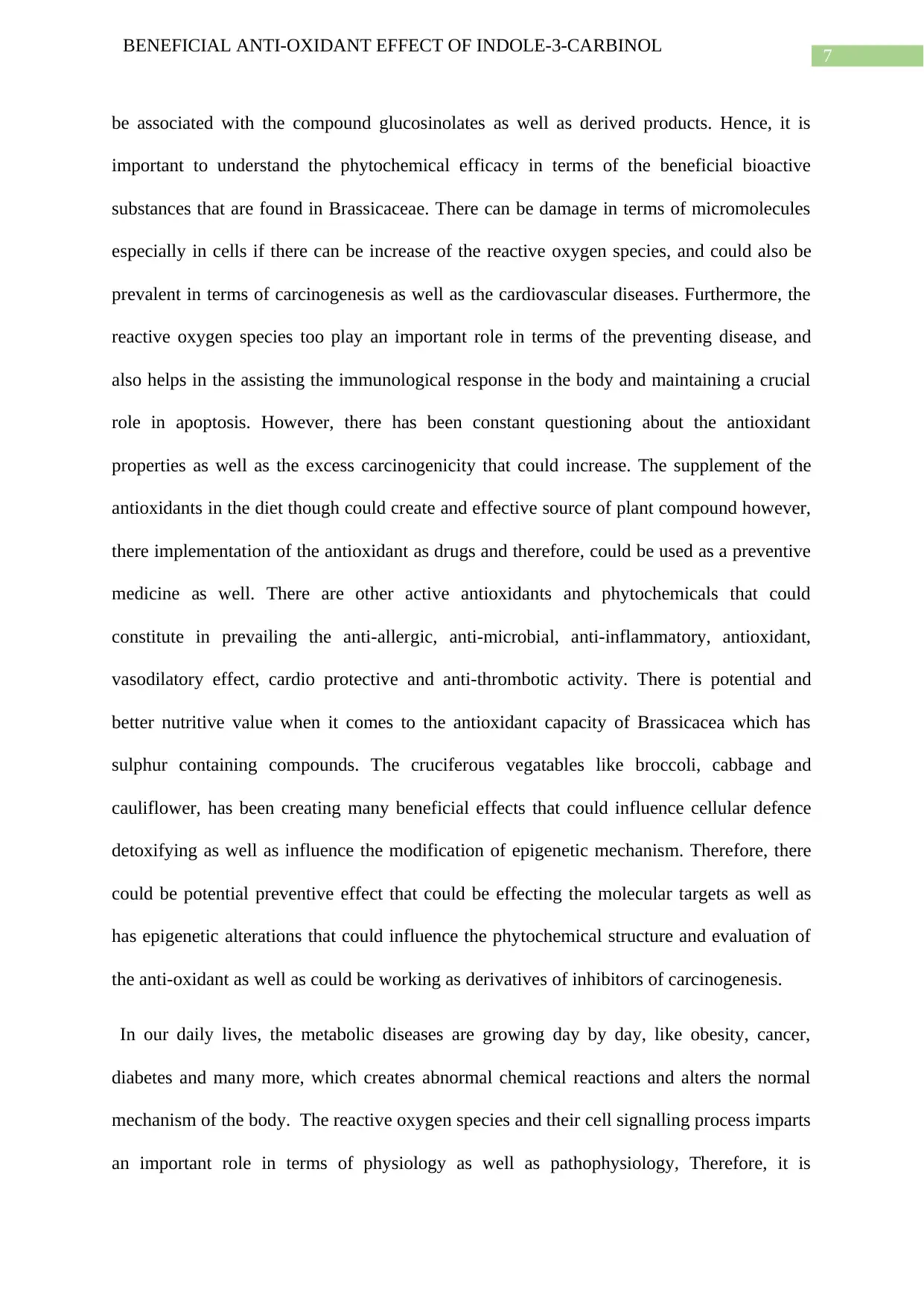
7
BENEFICIAL ANTI-OXIDANT EFFECT OF INDOLE-3-CARBINOL
be associated with the compound glucosinolates as well as derived products. Hence, it is
important to understand the phytochemical efficacy in terms of the beneficial bioactive
substances that are found in Brassicaceae. There can be damage in terms of micromolecules
especially in cells if there can be increase of the reactive oxygen species, and could also be
prevalent in terms of carcinogenesis as well as the cardiovascular diseases. Furthermore, the
reactive oxygen species too play an important role in terms of the preventing disease, and
also helps in the assisting the immunological response in the body and maintaining a crucial
role in apoptosis. However, there has been constant questioning about the antioxidant
properties as well as the excess carcinogenicity that could increase. The supplement of the
antioxidants in the diet though could create and effective source of plant compound however,
there implementation of the antioxidant as drugs and therefore, could be used as a preventive
medicine as well. There are other active antioxidants and phytochemicals that could
constitute in prevailing the anti-allergic, anti-microbial, anti-inflammatory, antioxidant,
vasodilatory effect, cardio protective and anti-thrombotic activity. There is potential and
better nutritive value when it comes to the antioxidant capacity of Brassicacea which has
sulphur containing compounds. The cruciferous vegatables like broccoli, cabbage and
cauliflower, has been creating many beneficial effects that could influence cellular defence
detoxifying as well as influence the modification of epigenetic mechanism. Therefore, there
could be potential preventive effect that could be effecting the molecular targets as well as
has epigenetic alterations that could influence the phytochemical structure and evaluation of
the anti-oxidant as well as could be working as derivatives of inhibitors of carcinogenesis.
In our daily lives, the metabolic diseases are growing day by day, like obesity, cancer,
diabetes and many more, which creates abnormal chemical reactions and alters the normal
mechanism of the body. The reactive oxygen species and their cell signalling process imparts
an important role in terms of physiology as well as pathophysiology, Therefore, it is
BENEFICIAL ANTI-OXIDANT EFFECT OF INDOLE-3-CARBINOL
be associated with the compound glucosinolates as well as derived products. Hence, it is
important to understand the phytochemical efficacy in terms of the beneficial bioactive
substances that are found in Brassicaceae. There can be damage in terms of micromolecules
especially in cells if there can be increase of the reactive oxygen species, and could also be
prevalent in terms of carcinogenesis as well as the cardiovascular diseases. Furthermore, the
reactive oxygen species too play an important role in terms of the preventing disease, and
also helps in the assisting the immunological response in the body and maintaining a crucial
role in apoptosis. However, there has been constant questioning about the antioxidant
properties as well as the excess carcinogenicity that could increase. The supplement of the
antioxidants in the diet though could create and effective source of plant compound however,
there implementation of the antioxidant as drugs and therefore, could be used as a preventive
medicine as well. There are other active antioxidants and phytochemicals that could
constitute in prevailing the anti-allergic, anti-microbial, anti-inflammatory, antioxidant,
vasodilatory effect, cardio protective and anti-thrombotic activity. There is potential and
better nutritive value when it comes to the antioxidant capacity of Brassicacea which has
sulphur containing compounds. The cruciferous vegatables like broccoli, cabbage and
cauliflower, has been creating many beneficial effects that could influence cellular defence
detoxifying as well as influence the modification of epigenetic mechanism. Therefore, there
could be potential preventive effect that could be effecting the molecular targets as well as
has epigenetic alterations that could influence the phytochemical structure and evaluation of
the anti-oxidant as well as could be working as derivatives of inhibitors of carcinogenesis.
In our daily lives, the metabolic diseases are growing day by day, like obesity, cancer,
diabetes and many more, which creates abnormal chemical reactions and alters the normal
mechanism of the body. The reactive oxygen species and their cell signalling process imparts
an important role in terms of physiology as well as pathophysiology, Therefore, it is
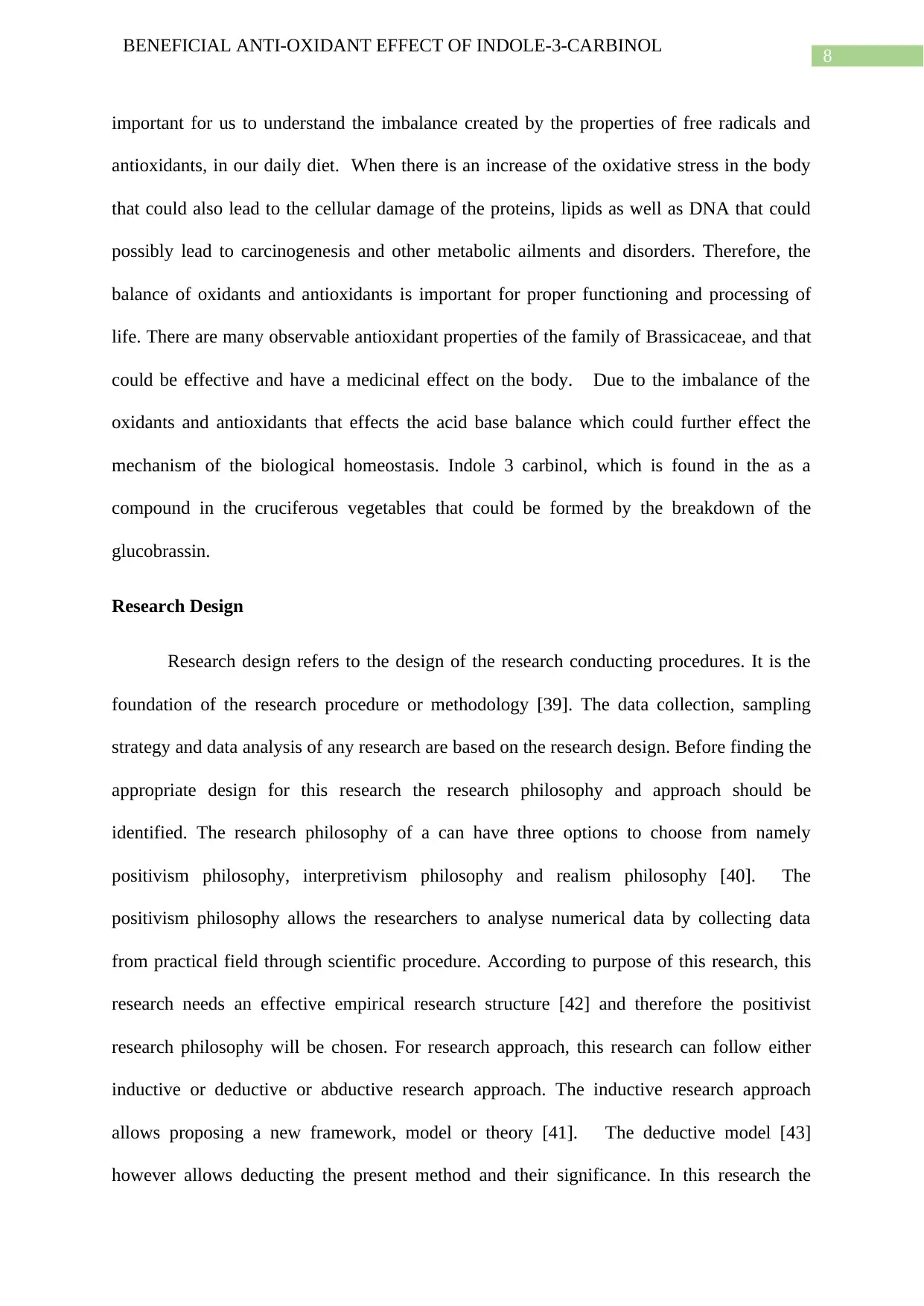
8
BENEFICIAL ANTI-OXIDANT EFFECT OF INDOLE-3-CARBINOL
important for us to understand the imbalance created by the properties of free radicals and
antioxidants, in our daily diet. When there is an increase of the oxidative stress in the body
that could also lead to the cellular damage of the proteins, lipids as well as DNA that could
possibly lead to carcinogenesis and other metabolic ailments and disorders. Therefore, the
balance of oxidants and antioxidants is important for proper functioning and processing of
life. There are many observable antioxidant properties of the family of Brassicaceae, and that
could be effective and have a medicinal effect on the body. Due to the imbalance of the
oxidants and antioxidants that effects the acid base balance which could further effect the
mechanism of the biological homeostasis. Indole 3 carbinol, which is found in the as a
compound in the cruciferous vegetables that could be formed by the breakdown of the
glucobrassin.
Research Design
Research design refers to the design of the research conducting procedures. It is the
foundation of the research procedure or methodology [39]. The data collection, sampling
strategy and data analysis of any research are based on the research design. Before finding the
appropriate design for this research the research philosophy and approach should be
identified. The research philosophy of a can have three options to choose from namely
positivism philosophy, interpretivism philosophy and realism philosophy [40]. The
positivism philosophy allows the researchers to analyse numerical data by collecting data
from practical field through scientific procedure. According to purpose of this research, this
research needs an effective empirical research structure [42] and therefore the positivist
research philosophy will be chosen. For research approach, this research can follow either
inductive or deductive or abductive research approach. The inductive research approach
allows proposing a new framework, model or theory [41]. The deductive model [43]
however allows deducting the present method and their significance. In this research the
BENEFICIAL ANTI-OXIDANT EFFECT OF INDOLE-3-CARBINOL
important for us to understand the imbalance created by the properties of free radicals and
antioxidants, in our daily diet. When there is an increase of the oxidative stress in the body
that could also lead to the cellular damage of the proteins, lipids as well as DNA that could
possibly lead to carcinogenesis and other metabolic ailments and disorders. Therefore, the
balance of oxidants and antioxidants is important for proper functioning and processing of
life. There are many observable antioxidant properties of the family of Brassicaceae, and that
could be effective and have a medicinal effect on the body. Due to the imbalance of the
oxidants and antioxidants that effects the acid base balance which could further effect the
mechanism of the biological homeostasis. Indole 3 carbinol, which is found in the as a
compound in the cruciferous vegetables that could be formed by the breakdown of the
glucobrassin.
Research Design
Research design refers to the design of the research conducting procedures. It is the
foundation of the research procedure or methodology [39]. The data collection, sampling
strategy and data analysis of any research are based on the research design. Before finding the
appropriate design for this research the research philosophy and approach should be
identified. The research philosophy of a can have three options to choose from namely
positivism philosophy, interpretivism philosophy and realism philosophy [40]. The
positivism philosophy allows the researchers to analyse numerical data by collecting data
from practical field through scientific procedure. According to purpose of this research, this
research needs an effective empirical research structure [42] and therefore the positivist
research philosophy will be chosen. For research approach, this research can follow either
inductive or deductive or abductive research approach. The inductive research approach
allows proposing a new framework, model or theory [41]. The deductive model [43]
however allows deducting the present method and their significance. In this research the
⊘ This is a preview!⊘
Do you want full access?
Subscribe today to unlock all pages.

Trusted by 1+ million students worldwide
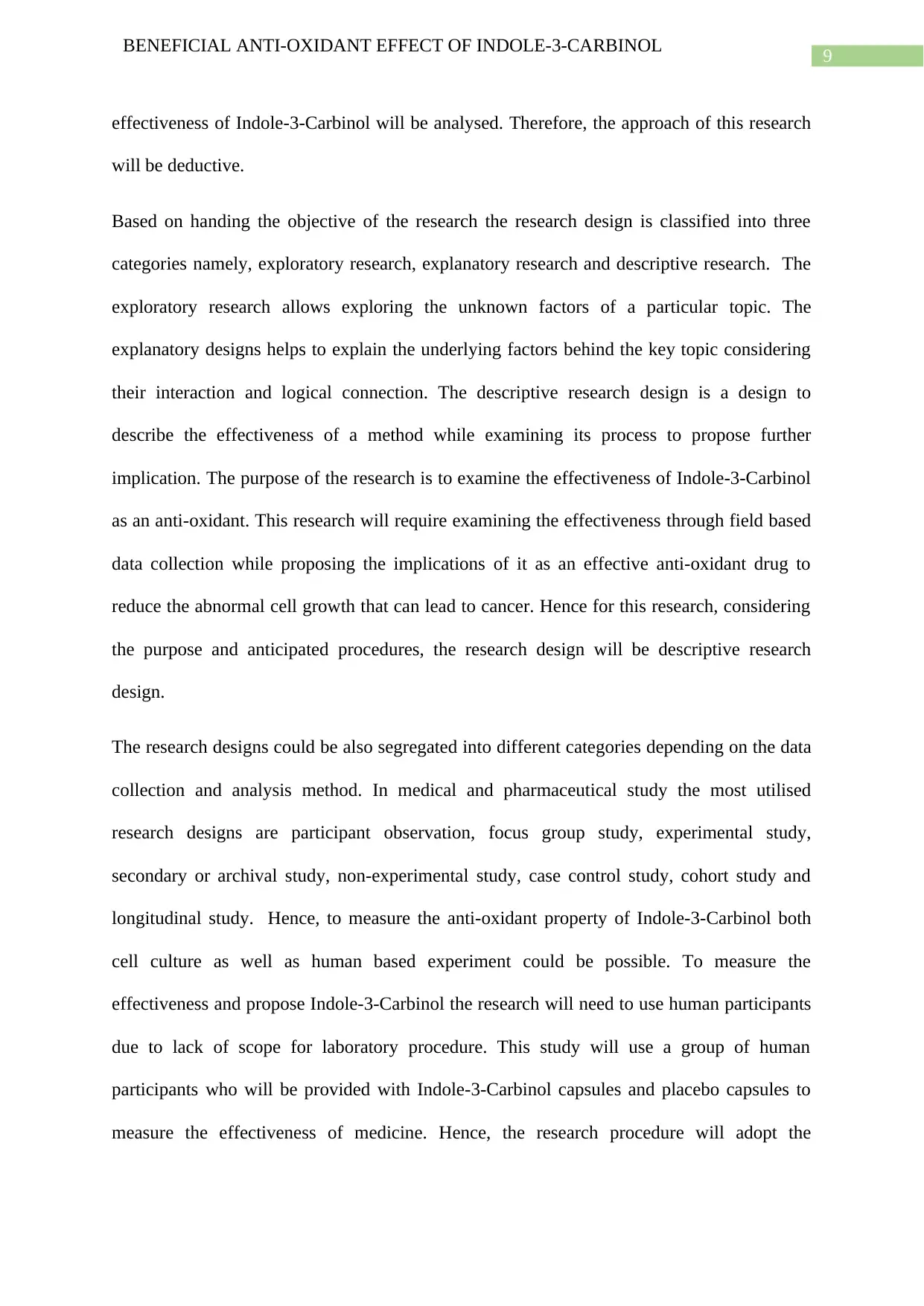
9
BENEFICIAL ANTI-OXIDANT EFFECT OF INDOLE-3-CARBINOL
effectiveness of Indole-3-Carbinol will be analysed. Therefore, the approach of this research
will be deductive.
Based on handing the objective of the research the research design is classified into three
categories namely, exploratory research, explanatory research and descriptive research. The
exploratory research allows exploring the unknown factors of a particular topic. The
explanatory designs helps to explain the underlying factors behind the key topic considering
their interaction and logical connection. The descriptive research design is a design to
describe the effectiveness of a method while examining its process to propose further
implication. The purpose of the research is to examine the effectiveness of Indole-3-Carbinol
as an anti-oxidant. This research will require examining the effectiveness through field based
data collection while proposing the implications of it as an effective anti-oxidant drug to
reduce the abnormal cell growth that can lead to cancer. Hence for this research, considering
the purpose and anticipated procedures, the research design will be descriptive research
design.
The research designs could be also segregated into different categories depending on the data
collection and analysis method. In medical and pharmaceutical study the most utilised
research designs are participant observation, focus group study, experimental study,
secondary or archival study, non-experimental study, case control study, cohort study and
longitudinal study. Hence, to measure the anti-oxidant property of Indole-3-Carbinol both
cell culture as well as human based experiment could be possible. To measure the
effectiveness and propose Indole-3-Carbinol the research will need to use human participants
due to lack of scope for laboratory procedure. This study will use a group of human
participants who will be provided with Indole-3-Carbinol capsules and placebo capsules to
measure the effectiveness of medicine. Hence, the research procedure will adopt the
BENEFICIAL ANTI-OXIDANT EFFECT OF INDOLE-3-CARBINOL
effectiveness of Indole-3-Carbinol will be analysed. Therefore, the approach of this research
will be deductive.
Based on handing the objective of the research the research design is classified into three
categories namely, exploratory research, explanatory research and descriptive research. The
exploratory research allows exploring the unknown factors of a particular topic. The
explanatory designs helps to explain the underlying factors behind the key topic considering
their interaction and logical connection. The descriptive research design is a design to
describe the effectiveness of a method while examining its process to propose further
implication. The purpose of the research is to examine the effectiveness of Indole-3-Carbinol
as an anti-oxidant. This research will require examining the effectiveness through field based
data collection while proposing the implications of it as an effective anti-oxidant drug to
reduce the abnormal cell growth that can lead to cancer. Hence for this research, considering
the purpose and anticipated procedures, the research design will be descriptive research
design.
The research designs could be also segregated into different categories depending on the data
collection and analysis method. In medical and pharmaceutical study the most utilised
research designs are participant observation, focus group study, experimental study,
secondary or archival study, non-experimental study, case control study, cohort study and
longitudinal study. Hence, to measure the anti-oxidant property of Indole-3-Carbinol both
cell culture as well as human based experiment could be possible. To measure the
effectiveness and propose Indole-3-Carbinol the research will need to use human participants
due to lack of scope for laboratory procedure. This study will use a group of human
participants who will be provided with Indole-3-Carbinol capsules and placebo capsules to
measure the effectiveness of medicine. Hence, the research procedure will adopt the
Paraphrase This Document
Need a fresh take? Get an instant paraphrase of this document with our AI Paraphraser
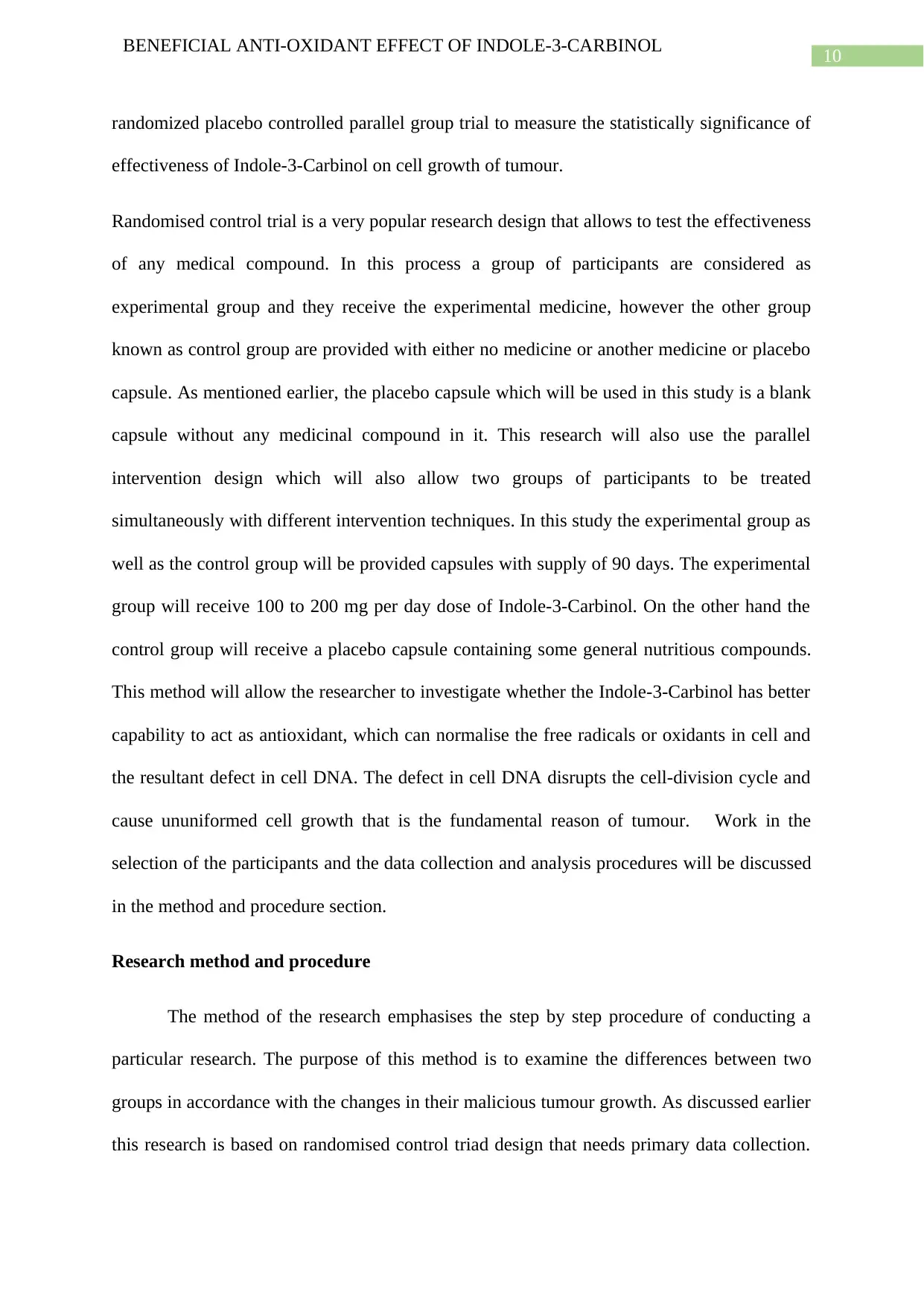
10
BENEFICIAL ANTI-OXIDANT EFFECT OF INDOLE-3-CARBINOL
randomized placebo controlled parallel group trial to measure the statistically significance of
effectiveness of Indole-3-Carbinol on cell growth of tumour.
Randomised control trial is a very popular research design that allows to test the effectiveness
of any medical compound. In this process a group of participants are considered as
experimental group and they receive the experimental medicine, however the other group
known as control group are provided with either no medicine or another medicine or placebo
capsule. As mentioned earlier, the placebo capsule which will be used in this study is a blank
capsule without any medicinal compound in it. This research will also use the parallel
intervention design which will also allow two groups of participants to be treated
simultaneously with different intervention techniques. In this study the experimental group as
well as the control group will be provided capsules with supply of 90 days. The experimental
group will receive 100 to 200 mg per day dose of Indole-3-Carbinol. On the other hand the
control group will receive a placebo capsule containing some general nutritious compounds.
This method will allow the researcher to investigate whether the Indole-3-Carbinol has better
capability to act as antioxidant, which can normalise the free radicals or oxidants in cell and
the resultant defect in cell DNA. The defect in cell DNA disrupts the cell-division cycle and
cause ununiformed cell growth that is the fundamental reason of tumour. Work in the
selection of the participants and the data collection and analysis procedures will be discussed
in the method and procedure section.
Research method and procedure
The method of the research emphasises the step by step procedure of conducting a
particular research. The purpose of this method is to examine the differences between two
groups in accordance with the changes in their malicious tumour growth. As discussed earlier
this research is based on randomised control triad design that needs primary data collection.
BENEFICIAL ANTI-OXIDANT EFFECT OF INDOLE-3-CARBINOL
randomized placebo controlled parallel group trial to measure the statistically significance of
effectiveness of Indole-3-Carbinol on cell growth of tumour.
Randomised control trial is a very popular research design that allows to test the effectiveness
of any medical compound. In this process a group of participants are considered as
experimental group and they receive the experimental medicine, however the other group
known as control group are provided with either no medicine or another medicine or placebo
capsule. As mentioned earlier, the placebo capsule which will be used in this study is a blank
capsule without any medicinal compound in it. This research will also use the parallel
intervention design which will also allow two groups of participants to be treated
simultaneously with different intervention techniques. In this study the experimental group as
well as the control group will be provided capsules with supply of 90 days. The experimental
group will receive 100 to 200 mg per day dose of Indole-3-Carbinol. On the other hand the
control group will receive a placebo capsule containing some general nutritious compounds.
This method will allow the researcher to investigate whether the Indole-3-Carbinol has better
capability to act as antioxidant, which can normalise the free radicals or oxidants in cell and
the resultant defect in cell DNA. The defect in cell DNA disrupts the cell-division cycle and
cause ununiformed cell growth that is the fundamental reason of tumour. Work in the
selection of the participants and the data collection and analysis procedures will be discussed
in the method and procedure section.
Research method and procedure
The method of the research emphasises the step by step procedure of conducting a
particular research. The purpose of this method is to examine the differences between two
groups in accordance with the changes in their malicious tumour growth. As discussed earlier
this research is based on randomised control triad design that needs primary data collection.
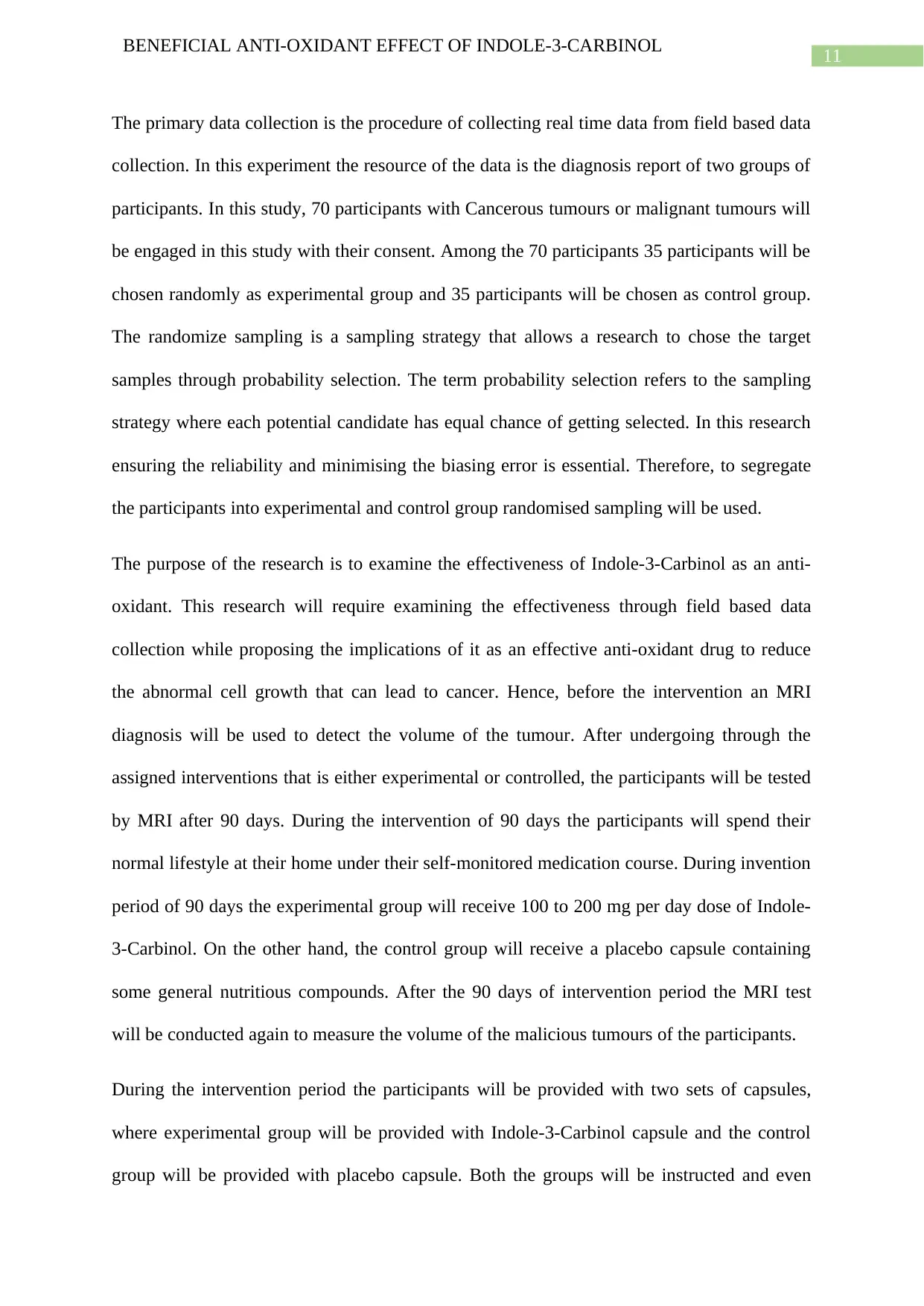
11
BENEFICIAL ANTI-OXIDANT EFFECT OF INDOLE-3-CARBINOL
The primary data collection is the procedure of collecting real time data from field based data
collection. In this experiment the resource of the data is the diagnosis report of two groups of
participants. In this study, 70 participants with Cancerous tumours or malignant tumours will
be engaged in this study with their consent. Among the 70 participants 35 participants will be
chosen randomly as experimental group and 35 participants will be chosen as control group.
The randomize sampling is a sampling strategy that allows a research to chose the target
samples through probability selection. The term probability selection refers to the sampling
strategy where each potential candidate has equal chance of getting selected. In this research
ensuring the reliability and minimising the biasing error is essential. Therefore, to segregate
the participants into experimental and control group randomised sampling will be used.
The purpose of the research is to examine the effectiveness of Indole-3-Carbinol as an anti-
oxidant. This research will require examining the effectiveness through field based data
collection while proposing the implications of it as an effective anti-oxidant drug to reduce
the abnormal cell growth that can lead to cancer. Hence, before the intervention an MRI
diagnosis will be used to detect the volume of the tumour. After undergoing through the
assigned interventions that is either experimental or controlled, the participants will be tested
by MRI after 90 days. During the intervention of 90 days the participants will spend their
normal lifestyle at their home under their self-monitored medication course. During invention
period of 90 days the experimental group will receive 100 to 200 mg per day dose of Indole-
3-Carbinol. On the other hand, the control group will receive a placebo capsule containing
some general nutritious compounds. After the 90 days of intervention period the MRI test
will be conducted again to measure the volume of the malicious tumours of the participants.
During the intervention period the participants will be provided with two sets of capsules,
where experimental group will be provided with Indole-3-Carbinol capsule and the control
group will be provided with placebo capsule. Both the groups will be instructed and even
BENEFICIAL ANTI-OXIDANT EFFECT OF INDOLE-3-CARBINOL
The primary data collection is the procedure of collecting real time data from field based data
collection. In this experiment the resource of the data is the diagnosis report of two groups of
participants. In this study, 70 participants with Cancerous tumours or malignant tumours will
be engaged in this study with their consent. Among the 70 participants 35 participants will be
chosen randomly as experimental group and 35 participants will be chosen as control group.
The randomize sampling is a sampling strategy that allows a research to chose the target
samples through probability selection. The term probability selection refers to the sampling
strategy where each potential candidate has equal chance of getting selected. In this research
ensuring the reliability and minimising the biasing error is essential. Therefore, to segregate
the participants into experimental and control group randomised sampling will be used.
The purpose of the research is to examine the effectiveness of Indole-3-Carbinol as an anti-
oxidant. This research will require examining the effectiveness through field based data
collection while proposing the implications of it as an effective anti-oxidant drug to reduce
the abnormal cell growth that can lead to cancer. Hence, before the intervention an MRI
diagnosis will be used to detect the volume of the tumour. After undergoing through the
assigned interventions that is either experimental or controlled, the participants will be tested
by MRI after 90 days. During the intervention of 90 days the participants will spend their
normal lifestyle at their home under their self-monitored medication course. During invention
period of 90 days the experimental group will receive 100 to 200 mg per day dose of Indole-
3-Carbinol. On the other hand, the control group will receive a placebo capsule containing
some general nutritious compounds. After the 90 days of intervention period the MRI test
will be conducted again to measure the volume of the malicious tumours of the participants.
During the intervention period the participants will be provided with two sets of capsules,
where experimental group will be provided with Indole-3-Carbinol capsule and the control
group will be provided with placebo capsule. Both the groups will be instructed and even
⊘ This is a preview!⊘
Do you want full access?
Subscribe today to unlock all pages.

Trusted by 1+ million students worldwide
1 out of 27
Related Documents
Your All-in-One AI-Powered Toolkit for Academic Success.
+13062052269
info@desklib.com
Available 24*7 on WhatsApp / Email
![[object Object]](/_next/static/media/star-bottom.7253800d.svg)
Unlock your academic potential
Copyright © 2020–2025 A2Z Services. All Rights Reserved. Developed and managed by ZUCOL.





